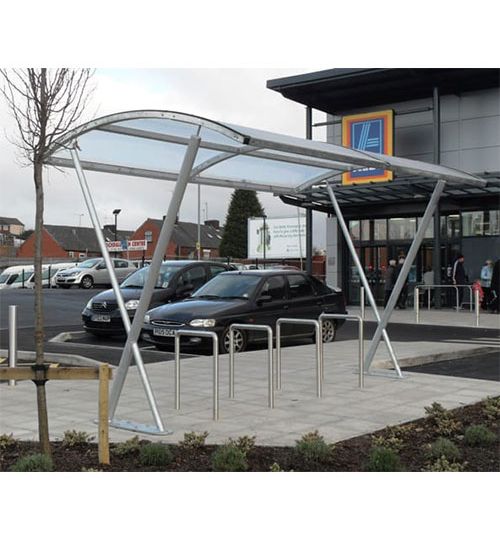
When it comes to outdoor shelters, having the right structure in place can make all the difference. Whether you need a canopy to protect against the elements, a smoking shelter for designated areas, or a cycle storage for commuters, the choices can seem overwhelming. That is why Tamstar have put together this guide—to help you understand the different types of shelters, their design styles, and answer some of the most frequently asked questions.
Why Are Shelters Important?
All of our outdoor facilities serve a variety of purposes across different environments. In commercial and public spaces, they provide protection, improve aesthetics, and enhance functionality.
For example:
- Businesses use canopy shelters to create welcoming entrances, protect outdoor seating areas close to buildings and provide weather-resistant spaces for employees and customers.
- Schools and parks install buggy, youth, and sport & recreation shelters to offer safe, structured spaces for young people and visitors.
- Public transport areas benefit from passenger waiting shelters that shield commuters from rain, wind, and sun.
- Car parks integrate car park shelters to protect vehicles from harsh weather conditions.
No matter the purpose, having the right outdoor facilities improves safety and usability for everyone.
Types of Shelters
-
Canopy Shelters
Canopy shelters are versatile and commonly used to provide overhead protection. They are ideal for businesses, schools, and commercial buildings looking to create covered walkways or shaded seating areas. Available in different materials like steel frames and Perspex polycarbonate glazing, they can be designed to complement the existing structure.
-
Polycarbonate Shelters
These shelters are constructed using polycarbonate roofing, known for its durability, transparency, and resistance to weather conditions. Polycarbonate is often used in cycle storage areas, smoking shelters, and outdoor waiting areas. As a result, this offers a blend of protection and natural light as well as being UV stable.
-
Smoking Shelters
Since the smoking ban in enclosed public places, many businesses and public spaces have installed smoking shelters to provide designated areas for smokers. These help keep entrances and walkways clear while ensuring compliance with regulations.
-
Sports & Spectator Shelters
Outdoor sports facilities and stadiums use sports & spectator shelters to offer cover for players, coaches, and audiences. These can be open sided for airflow or enclosed to provide greater weather protection. In fact, they are also sometimes known as dug out shelters.
-
Bandstands
Bandstands serve as decorative yet functional outdoor performance spaces, commonly found in parks and community areas. Designed to accommodate musicians, speakers, and performers, they offer shelter while enhancing the aesthetic appeal of public spaces.
-
Buggy Shelters
For parents and childcare providers, buggy shelters offer a safe and secure place to store prams and strollers. These are particularly useful in schools, nurseries, and shopping centre’s, where parents frequently need to park their buggies.
-
Passenger Waiting Shelters
Commonly found at bus stops, train stations, and transport hubs, these shelters ensure that passengers can wait in comfort. Best of all, this is regardless of the weather conditions whilst they wait for transport to arrive.
-
Car Park & Ticket Machine Shelters
These protect vehicles from sun, rain, and snow, preventing damage caused by prolonged exposure to the elements. Businesses often install these to enhance the value of parking facilities for employees and customers. They also help protect both users and car park ticket machines from weather damage.
-
Outdoor Bin Stores & Storage Shelters
Outdoor bin stores keep waste management areas tidy and secure. These storage shelters are essential for commercial properties and public spaces, helping to keep bins enclosed and protected from pests.
-
Youth Shelters
Designed as social spaces for young people, youth shelters provide a covered area where groups can gather safely. In fact, these are often installed in parks and recreational areas to create structured environments for social interaction.
-
Sport & Recreation Shelters
These are tailored to meet the needs of sporting facilities, playgrounds, and fitness areas. Whether for team meetings, spectators, or individual training spaces, they offer much-needed protection from unpredictable weather.
Different Styles of Shelters
Choosing a shelter isn’t just about function—it is also about aesthetics and structural design. So, here are some common styles:
- Mono-pitch: A simple, single-sloped roof that directs rainwater in one direction.
- Duo-pitch Symmetric: A classic, V-shaped roof where both sides slope evenly.
- Asymmetric: A unique design where the two roof pitches are uneven. Thus, this creates a more modern look.
- Cantilever: A structure that extends outward without vertical supports, so offers a spacious feel.
- Gull-wing: A stylish, curved roof resembling a bird’s wings.
- Central Column: A shelter supported by a single central post, providing 360-degree access.
- Hyperbolic: A striking, curved design with dramatic aesthetics.
- Curved Roof: Smooth, rounded roofing for a contemporary and elegant look.
Frequently Asked Questions (FAQs)
Can you design the shelter to suit our site?
Yes! In some cases outdoor facilities can be custom designed to match specific site requirements. Whether you need a structure to fit a particular space or match your building’s aesthetic, design flexibility is available.
Can you assist in designing the foundations?
Most shelter manufacturers offer foundation design services to ensure stability and compliance with structural regulations.
If positioning my shelter close to a building, will it be watertight?
Proper sealing techniques and materials ensure that the connection between the shelter and building is waterproof, preventing leaks.
Can I have enclosed sides on my shelter?
Yes! Depending on the purpose, shelters can have open or enclosed sides for added protection and security.
What material options do I have for the structure?
Common materials include steel, aluminium, timber, and polycarbonate, each offering different levels of strength, durability, and design flexibility.
What roofing materials are available?
Roofing options include polycarbonate panels, metal sheeting, glass, and even fabric. Therefore, this allows for customisation based on weather resistance and light transmission.
Do I need rainwater goods like guttering?
For larger shelters, guttering and drainage systems may be necessary to prevent water accumulation and direct runoff safely.
Will I need Planning Permission?
Depending on the size and location, some shelters may require planning permission. As a result, it is best to check with local authorities before installation.
What are Building Regulations, and how will they affect me?
Building Regulations ensure that shelters are structurally sound, safe, and compliant with legal standards. Therefore, every commercial installation should adhere to these guidelines.
Do shelters account for wind and snow loadings?
Yes! High-quality shelters withstand various weather conditions, for example strong winds and heavy snowfall.
Are these structurally underwritten?
Most steel fabricators provide structural warranties or certifications to guarantee durability and compliance with safety standards.
Do you provide an installation service?
Yes! Here at Tamstar we offer a professional installation, so will ensure proper setup and compliance with regulations. We also work closely with groundworks contractors to manage any addition groundworks required e.g Concrete base.
Installations from Tamstar
Our outdoor facilities come in all shapes and sizes, and choosing the right one depends on the intended use, available space, and aesthetic preference. Whether you need a smoking or passenger waiting shelter, cycle storage solution, or a bespoke canopy, there are plenty of options to suit different needs.
By investing in the right outdoor facilities, businesses, schools, and public spaces can create comfortable, practical, and visually appealing environments. If you’re ready to explore the best shelter solutions for your site, reach out to professionals who can help design, supply, and install a shelter that meets your requirements!
